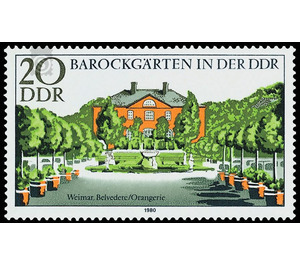Baroque gardens - Germany / German Democratic Republic 1980 - 20 Pfennig
Theme: Architecture
| Country | Germany / German Democratic Republic |
| Issue Date | 1980 |
| Face Value | 20.00 |
| Color | green |
| Perforation | K 14 |
| Printing Type | Rotogravure 2 |
| Stamp Type | Postage stamp |
| Item Type | Stamp |
| Chronological Issue Number | 2229 |
| Chronological Chapter | GER-DDR |
| SID | 175242 |
| In 25 Wishlists | |
Baroque gardens in the GDR With the representation of baroque gardens in the GDR, the Ministry of Postal and Telecommunications of the German Democratic Republic issued four multi-colored special postage stamps. Special cancellations from January 29 to March 28, 1980 Baroque gardens in the GDR The gardens and parks in the GDR are important pieces of garden art as an important part of our national and cultural heritage. They document the development of garden art, the relationship of man to nature under the prevailing social conditions and are cultural centers within the green space system of towns and villages or large-scale cultural landscapes places of education and recreation. Their high esteem is also expressed by the steadily increasing number of visitors, so that they are of particular importance within the framework of national and international tourism. State and social efforts serve the maintenance and preservation of this category of art in order to involve it more in the life of society as a whole. Due to their historical, artistic or scientific significance, the most important sites were therefore protected as monuments of landscape and garden design (Preservation Act of 19 June 1975). In the care of these works of art, the monument preservation aspects are in the foreground. They are aimed at preserving the peculiarity of the individual plants according to their style characteristics. The gardens and parks from the second half of the 17th century and the first half of the 18th century, the Baroque gardens, are an important period in the development of German garden art. The plants Großsedlitz, Weimar-Belvedere, Dornburg and Rheinsberg, which are featured on the special postage stamps, belong to the most important plants of this epoch and are therefore included in the central list of monuments of the GDR. At the same time, these objects document the intensive efforts to preserve the garden heritage. 20-pfennig value: Weimar, Belvedere / Orangerie Orangeries with a variety of rare tropical and subtropical plants belonged to the fixed equipment of a baroque plant. In addition to the passion for collecting, the plants kept in containers served as a precious possession of the representational need. The orangery in the Belvedere in Weimar was built from 1739 to 1753 according to plans by G.H. Krohne (1703 to 1756) as a horseshoe-shaped plant.


